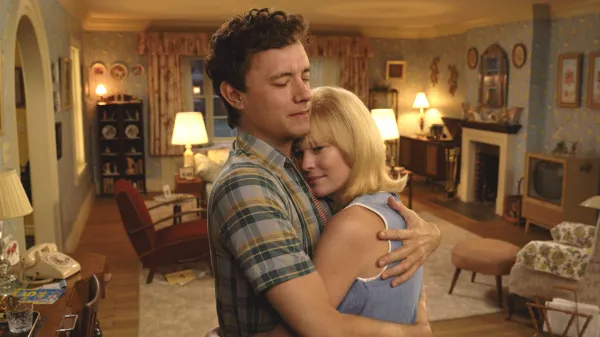Here
Posted on October 31, 2024 at 12:33 pm
B-| Lowest Recommended Age: | Middle School |
| MPAA Rating: | ated PG-13 for thematic material, some suggestive material, brief strong language and smoking |
| Profanity: | Some strong language |
| Alcohol/ Drugs: | Drinking and alcohol abuse |
| Violence/ Scariness: | Sad deaths and medical problems, references to wartime injuries and deaths |
| Diversity Issues: | Treatment of BIOPC characters superficial |
| Date Released to Theaters: | November 1, 2024 |
Near the end of the multi-generational saga “Here,” a character mentions that the time he spent caring for his difficult father in his last years helped them have a better, more understanding relationship. This is tell, not show, the opposite of what a movie is supposed to do. In this case, that really important part, the show part, is a lower priority than the movie’s conceptual and technology gimmicks.
“Here” is based on a graphic novel by Richard McGuire. Its conceit (in both senses of the word) is that the whole story takes place on one spot, going back millions of years, before there was any life on Earth, then with plants, then dinosaurs trampling across, then people, an indigenous couple, a Colonial era man (the royalist son of Ben Franklin) and the enslaved people who resignedly salute him as his carriage passes. A house in what will be the suburbs is built in 1911. Its first owners are a Victorian couple, then an inventor and his devoted wife, much later a Black family in contemporary times, and, in between the central focus, a WWII veteran and his wife, and their three children, one who grows up to be played by Tom Hanks, de-aged by CGI, then looking like he lives now, then aged to show how he may/will look in 20 years. The content of these stories is designed to trigger reactions more based on our own experiences of the big life moments — love, loss, job woes, marriage, family conflict, Thanksgiving, babies, aging parents, more Thanksgivings, a wedding, a funeral — than on any connection to these characters. Our hearts may be tugged at because we are humans who cannot help identifying with these touchstones, but it’s all as synthetic as astroturf.

This film reunites the “Forrest Gump” team, Hanks as Richard and Robin Wright as his wife, Margaret, along with composer Alan Silvestri, cinematographer Don Burgess, screenwriter Eric Roth, and director Robert Zemeckis, who co-wrote the screenplay. Zemeckis, as he does too often, seems far more interested here in the technology than the storyline. The camera placement is static, always the same location in the house’s living room, facing the bay window across from what was once the Colonial plantation. Unlike the images in a graphic novel, movies have to have movement; it;’s in the name. So what we have is a lot of boxes coming in and out of the screen with glimpses of what is happening or did happen that may be contrast or commentary on the cyclicality of events or may just be there to remind us what time we’re in: the Beatles on Ed Sullivan! Jane Fonda’s exercise tapes! And then there are the technology touchstones. Radio, then television. The first cordless phone.
It reminded me of the Carousel of Progress at Disney World, and to be honest, the animatronic characters in that revolving audience show created for the New York World’s Fair in 1964, have more personality than most of the one-attribute characters in “Here.” That is unfortunately even more true of the characters of color in the film. The Black family seems to be there only to show us The Talk with their teenage son about how to behave if he gets pulled over by the police for a traffic violation. Their Latina housekeeper exists only to show us the pandemic. The indigenous people are like the dinosaurs — they exist only to disappear.
Parents should know that this film includes many family ups and downs including conflicts, divorce, serious illness, and death. There is a teenage pregnancy. A WWII veteran with injuries and PTSD self-medicates with alcohol. A young husband and father dies. There are sexual references, scanty attire, references to racism, and some strong language.
Family discussion: What would you want to say to the families who live in this house? Why didn’t Richard want to move? How did the characters decide to compromise on their dreams?
If you like this, try: the book by Richard McGuire, the Thornton Wilder play “The Long Christmas Dinner,” and the 1961 short film “The House”
